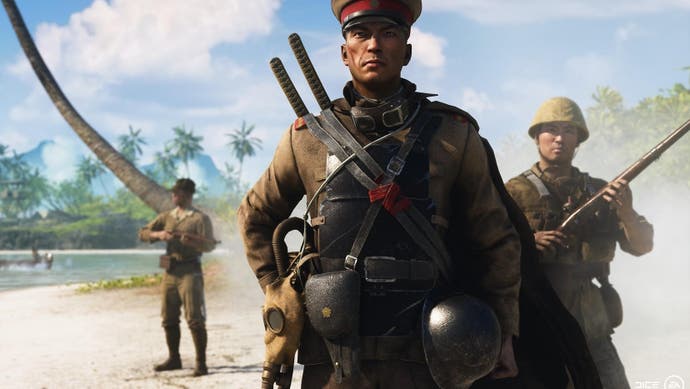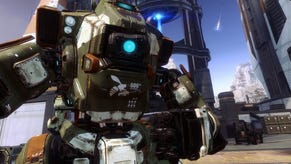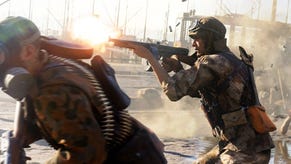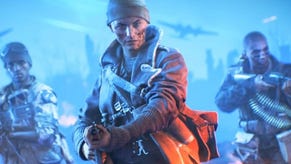With no new title on the near horizon, Battlefield is returning to its roots
Why DICE is focussing on making Battlefield 5 great.
When Battlefield is good, it's really, really good. There's a magic to be found when zipping to a distant capture point in an armoured vehicle, your friends in tow as you man the rear guns and take potshots at the fighter plane above that then comes screaming down in a streak of fire and crashes into a building, sending it tumbling to the ground and taking out the squad that was camping there. It's breathless stuff - and when Battlefield's sandbox delivers, there's nothing quite like it.
Of course, there's the other side to Battlefield as well. The one where you're running aimlessly across a vast map, not entirely sure where to head next, and having your long journey to a capture point cut short by some sniper camping out on some faraway hill. It's frustrating to the extreme. Or maybe you just fell foul to one of the many glitches to be found. When Battlefield's bad, it can be really, really bad.
True to form, Battlefield 5 has offered a bit of both. It launched just under a year ago, undercooked and with support in its first few months patchy at best. Firestorm made a belated debut earlier this year, and offered a fascinating take on the Battle Royale genre, though support seems to have petered out, while elsewhere new maps were only being added sporadically. Being a Battlefield 5 player has been, more often than not, a deeply frustrating experience.
Turning around struggling games has become something of a DICE speciality, starting with Battlefield 4 - one of the more disastrous launches in recent years, yet a game that went on to become one of the most cherished multiplayer shooters of the generation. Even Star Wars: Battlefront 2, which rightfully attracted controversy around its launch, has been turned around. I dipped in recently to see where it's at, and was pleasantly surprised; it's actually good now.
Battlefield 5 never really attracted the same ire, but it's certainly benefited from the same kind of care and attention in recent months. The rate at which maps have been added has amped up, and this week sees arguably the biggest addition to Battlefield yet with the addition of the Pacific theatre. It's a pointed return to the series' roots, bringing it all back to maps that riff off the classics that featured in 2002's Battlefield 1942.
There have been some tweaks. Iwo Jima, which heads up the new expansion, takes the Battlefield 1942 original and expands upon it. Visually it's a bit more muted - cues have been taken from cinematic depictions of the conflict, most notably Clint Eastwood's Flags of our Fathers and its companion piece Letters from Iwo Jima - with the volcanic geology making the beaches feel like a moonscape. There's more detail, too - those wide expanses on the front give way to a network of tunnels through Mount Suribachi, both of which combine for a map that provides a variety of different styles.
Play it in Breakthrough and you get Battlefield 5's own take on storming the beaches as you invade the island when playing as the US forces. Invasion's a big part of what this particular expansion is about, so Breakthrough seems like the perfect way to embody all that. When you're playing as Japanese forces, you're on the backfoot, fortifying defences and pushing back against the invading forces. It gives this expansion its own particular flavour.
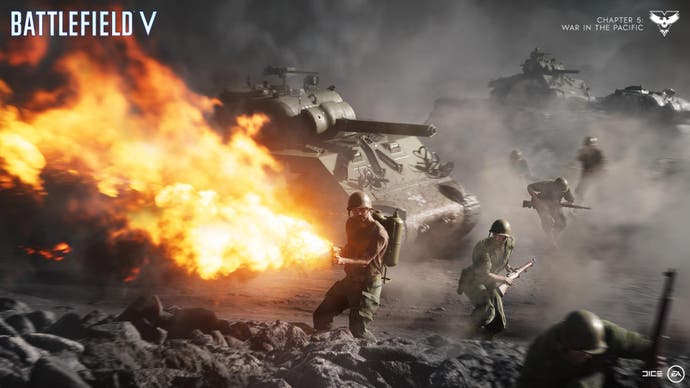
Pacific Storm's the other new map, which brings to mind another piece of cherished Battlefield history. This time out it's Battlefield 4's Paracel Storm that's the inspiration, with an archipelago being battered by DICE's dynamic weather system. That cluster of islands also means that water-faring warfare is a very real option, with a battered dinghy that's one of the new vehicles in this new expansion the perfect vehicle to stealthily storm a point.
Really, though, it's the most iconic Battlefield map of them all that's the star attraction - even if it's not coming until a little further down the line in December. War in the Pacific reintroduces Wake Island, though at present it's still under construction so our own playtest wasn't available for capture. Rest assured it's faithful to the original, with what feels like a slightly larger scale and more fidelity in its telling. The horseshoe layout of the island still makes for amazing encounters, too, with boats zipping from coast to coast in a distillation of all that's great and good about the Battlefield series.
Indeed, War in the Pacific feels like a pointed return to the foundations of Battlefield, and a return to all the traits that made everyone hold the series so dear. It's been a bumpy ride for Battlefield 5, with its sporadic updates, a road map that was soon thrown out the window and the frustrations of players having to put up with frequent bugs. War in the Pacific puts it all back on surer footing, and it comes off the back of a period of increased support for Battlefield 5 from DICE that makes it all a much more palatable offering. If you've been holding off on this for a while, perhaps now's the time to dive in. After this update, Battlefield 5 is, more often than not, really really good.
Soon after our hands-on session with Battlefield 5's expansion, it emerged that there's no new Battlefield coming next year - and it seems that DICE is finally being given some room to breath, and there's hope that next time around it can launch a game in strong shape rather than having to scramble to fix things as it's done in the past. I sat down with Lars Gustavsson, a veteran of the series having been at DICE since its inception, to talk about Battlefield's recent past, and it's near-future too.
We're coming up to 12 months since Battlefield 5 came out. What would your assessment be of that first year?
Lars Gustavsson: It's been quite a journey. Coming back to the Second World War and all the possibilities that brings, but also all the expectations. It's an era that's been out there in so many movies and so many games. And then coming out and scrambling, and shifting our mindsets much more to a live service - especially when we're used to premium model - and trying to unify the community. Which ultimately was the biggest flaw with premium - it splintered the community. So from that perspective, I think it's been quite a ride!
Pushing hard to do more frequent updates and listen in to the community - especially now, from from summer to autumn we've refocused our efforts and push with the most recent updates - large conquest and most recently with Operation Underground. I think there's definitely something very positive growing in the community which makes me happy. I was just watching the phone as you stepped into the room as the trailer hit.
I was just on the Reddit and everyone's just over the moon with the new trailer. It's gone down very well. So it seems like Battlefield 5 is in a better place now but the cadence of updates was was quite erratic at the start. Was it harder adapting to the live service model than you anticipated?
Lars Gustavsson: As a studio I often say - I mean it's a big studio, it's a part of big EA and it's often probably perceived as such on the outside as well. Sometimes we get it you know, it's a big company and a big machine. But as the market grows continuously, tech evolves and the world around us changes there's no shortage of learnings. So just all the learnings we have picked up to in the last year - how do we work with Tides of War. What works? What do people engage with? When do we make it too hard? What are people expecting? You know, week after week of tonnes of learning, so and also all the hard work that just goes into the process of having a big team cramming out fixes, some content, and then delivering it to our players. So it's big machinery, beyond building a few maps and getting them out there.

What was the bottleneck in terms of getting that content out there?
Lars Gustavsson: I think overall, I think I mean, for us, the biggest one has been to, to focus our efforts. And I think a big part for us is really working with internal processes and being smart about it. I remember when we did Codename Eagle or Battlefield 1942 - it might have topped 25 people or something. But these days, teams are so much bigger and it's very easy that you don't get the flow you won't with communication, especially when you have constant deadlines to work with. That's a constant strain on the team.
So I think sometimes, you know, working harder and all of that doesn't work. I think for us working with the processes and simple things like the daily stand ups, how can we make it better, and make communication flow? And also externally, how do we talk to our players to handle expectations, to be transparent with where we're heading, but go into details as we get closer to it rather, to send the right expectations. We're learning along the way, and I think that's part of it. I think the whole industry is in a transformation right now - or maybe it's wrong to say right now since 10 years back people talked about PC dying, only the titles will live. Then suddenly you mobile, Xbox Live Arcade and everything. So the world has always been in transformation. As developers, it's not only to continue to deliver cool experiences but it gets more and more important how you do it in a way where you stay healthy as a company and as individuals. And also please your players.
There's players coming down on you saying they want more updates, and that must be a strain internally.
Lars Gustavsson: It's like Mr. Ford said in regards to the faster horse. Sometimes you also need to listen and listen carefully what they say. But what does it ultimately mean that they want? Is it a symptom or the course that you're trying to get to. A lot of the behind the scenes work is looking at behaviours and what works well - these days with telemetry it's easier to follow. But that's in itself takes a lot of time. So I think we're learning a lot in how to work closer with our players and be guided by data, guided by communication with players and also, in order to not build a faster horse but a car. You also need to have your gut feel, your expertise in the building to dare to take that next step.
Data is obviously really good but also instincts are important. I'm sure when you were making Battlefield 1942 that wasn't so much data driven. That was more asking what would be cool.
Lars Gustavsson: If we'd have listened to people... Every publisher said you can't do it. And that's probably became a spark for that underdog mentality. Yeah, say we can't do it. Well, I'll show you. And for me that's what's been the mentality of DICE. Mirror's Edge tried something that no one else had done before. With Battlefield we've been constantly trying to push forward and do things that other shooters just don't do. Equally to bring the franchise forward but also to prove to ourselves and to the world that we can do cool things. Since I think going to work knowing that there's gold in them hills. We just need to find it before anyone else does, I think is what triggers me as a developer.
For example now when we've been building Pacific and so reassessing kind of what we have out there today, and where do we continue when we knew early on that it was clear from community they wanted to go to the Pacific. That's where the franchise started in many ways as well. We also want to see how do we continue to evolve gameplay - we open up maps bit more, include more tools in the world for you to play with. And constantly having, you know, one ear on where community is and then trying to interpret that and bring it forward. With more room and space, there's more time to be outsmarting players. There's more room for team play. There's more ways of enabling the full sandbox.
These maps, the ones we're playing - they seem to kind of display a slightly different philosophy to the map design. What would you say that new philosophy is?
Lars Gustavsson: On a very high level it's reinforcing the sandbox even more. With the franchise we've gone between super big to expansion packs with super small maps as well. These days I work with producers, but for many years I was creative director and we have this set of Battlefield pillars, which is about the sandbox, the land, sea and air and all of that. They're not do or die pillars, they won't make the game for you. But what they do is they forced yourself to deliberately stray from any of the pillars at a certain time and make a deliberate decision. For close quarters and Battlefield 3, we decided to not have vehicles since we wanted to do something we're never done before or by removing something else. But it should always be deliberate decisions. And I think with that, I think now pushing harder for the sandbox and what makes Battlefield Battlefield is something that I think is very hot in the team right now. Which I find interesting - the market's constantly moving forward in all directions. All our colleagues out there in the market are striving to build new experiences. We're developers, but we're also gamers, we play other games and look at trends and what we can learn. Sometimes you hate yourself, thinking I should have come up with that? But all in all, I think all games benefit from it.
A new Call of Duty has just come out. Two or three years ago I'm sure every question you got would have been along the lines of whether this is the year you're going to beat Call of Duty. I'm guessing that kind of question doesn't come up anymore, for reasons both good and bad. Is it good that you're not under that pressure anymore, or are you still pushing to make Battlefield the premier shooter on the market?
Lars Gustavsson: As you say, I've we've had tonnes of conversations around that - it was a hot topic around Battlefield 1. But I mean, I played Medal of Honour - Medal of Honour came out around the launch of Battlefield 1942. People came back from E3 and were super scared. 'Their game looks better than ours!' We worked super hard over that summer to beat it, but then we had 64 players - they didn't. But the customer won't care will they? It's fair. Okay, let's let's make it look better.
To me once again - we play all of those games and also tried to get people to play the lesser known titles to pick up sparks and ideas from other games. I don't think it's either you have to play CoD or you have to play Battlefield or you have to play Halo or PUBG. I think they all have their place in the market. I think Battlefield still has a very interesting proposition on the market where the big sandbox and the player told stories, to me at least, it feels almost stronger than ever to me when I play Iwo Jima in Breakthrough - from that beach landing all the way up through the tunnels and up to that mountain top, I think Battlefield with the combination of land, sea and air, the teamplay abilities, interactive world with dynamic weather, fortifications and all of that, it gives it a unique flavour on the market.
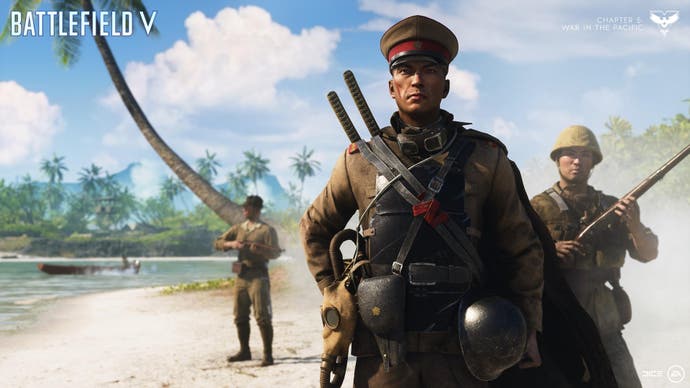
When it comes together, there's nothing like it. I've had two or three of those moments just on the last three hours where it's like, wow.
Lars Gustavsson: I mean no one wants to get old and stale. But I think what's what keeps us all together is the hunger for doing something that no one else has done before. With lots of new, younger people coming in the company who are super hungry as well, it's a good combination of not being the the old fart who sits there and say no no, we can't do that since we tried that before, but rather guides that and say we tried this it didn't pan out, we think because of this certain reason. Can you do it? I'm all for it. It's interesting as the game development world grows older, and as a franchise I think it's healthy to to push yourself. You can't rely on what you've done since you will always be valued on what's next.
One cool experiment with 5 was Firestorm, though and support has dwindled. Is this something you're still going to support going forward?
Lars Gustavsson: It's something that we saw really sparked player's interest and there have been updates. Right now we've been doing an overall big quality push, since summer. Right now the main focus is on the Pacific. So that's basically where we stand right now. And where we take the game as a whole, and moving forward, that's for the future to tell. Once again, we've learned so much from the different experiences that we provide, and how players consume and perceive it. It's interesting times,
You gave a fair assessment of where Battlefield 5 is a year after launch. What do you think about the series as a whole? There have been dips and troughs, and I think momentum was sapped a little by the launch of Battlefield 5 but it's picking up again. Where do you see it yourself?
Lars Gustavsson: I often get the question of how can you work with the same game company for more than 20 years. But to me, I mean, the game has changed so much through the years, even though the core pillars are still there. And as a company we've gone through so many changes - people come and go. What I really like about dice right now is we're working equally much with the question of where we take gaming in the future as well as how do we make games in better ways.
We've been building tonnes of big titles the last few years with Battlefront and with Mirror's Edge and Battlefield 1 and Battlefield 5. So we've been very product focused, but now it's a big kind of push for how do we work with better process, how do we work with better tools? And in general, how do we work better with live games that we continuously can work with and support? So from that perspective, I think it's I even though I haven't moved company constantly, like some people do, I still feel like I've been through at least 10 companies through the years.
And on a personal level - we've done so many different types of Battlefield over the years. I think all of them have something that I really like. There's definitely been the ones that have been bigger commercial hits, and the ones that haven't reached the same way, but there's always.
I think, even though the conversations you see [online], that we're always hardest on ourselves, to see how can learn, how can we remedy, what is the next step forward to not be too short sighted but always make sure that we build a stronger company with even happier employees and to not you burn all our money here and now and party like there was no tomorrow. Even though that sounds kind of beautiful.
This article is based on a press trip to Stockholm. EA covered travel and accommodation costs.
